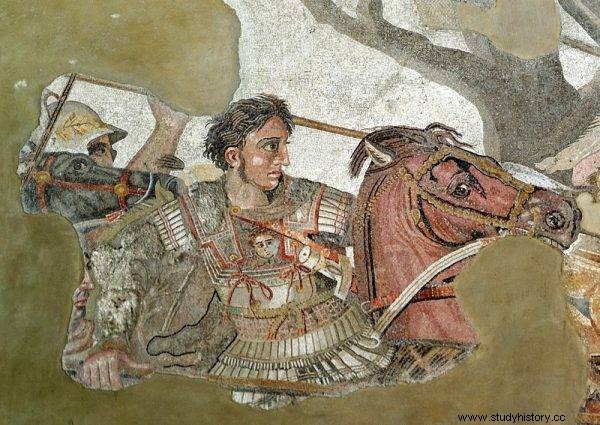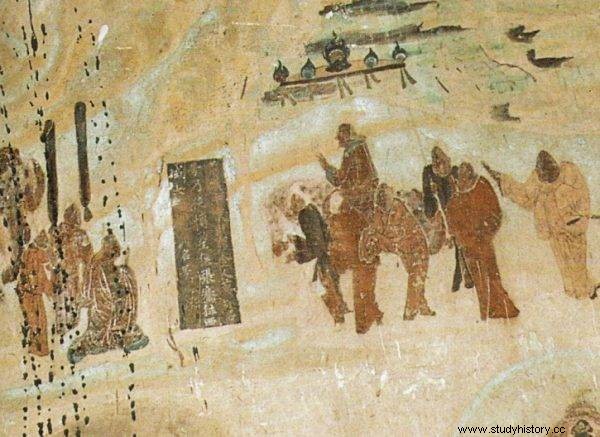If history has taught us anything, it is that people can persistently and reasonably work for peace in the future. The best example of this were the Silk Roads, which centuries ago were followed by merchants trading in rare, exotic goods. They also exist today. To understand them, however, you first need to understand the past.
The first civilizations were born in Asia. The first cities known to us arose in Mesopotamia along the banks of the great rivers of Tigris and Euphrates and in the valley of the Indus River. The conditions were particularly favorable there. Babylon, Nineveh and Uruk in Mesopotamia or Harappa, Mohenjo-Daro and Dholavira in the Indus Valley, thanks to easy access to water, allowed the inhabitants to lead a healthy and clean life. The water also helped to grow plants in the fertile riverside fields. This is probably why many people believed that mankind was born in Mesopotamia (whose name literally translates to "land between the rivers").
However, for states to survive, strong power was not enough - an efficient organization was also needed. The rulers were aware of the importance of law and order, so it is not surprising that the first codes were created along with the first civilizations. One of them was the Hammurabi Code. It was written 4,000 years ago at the behest of the ruler of Babylon. Roads were also built allowing goods to be quickly transported over a distance of hundreds of kilometers. The kings made sure that merchants did not cheat their customers and provided them with goods of the appropriate quality. Taxes were not only levied and collected efficiently but (usually) fairly.
Ancient Wheel of Fortune
The greatest ancient empire was Persia, stretching from the Mediterranean Sea to the Himalayas. In such cities as Persepolis, Pasargada or Suza, beautiful buildings were erected, testifying to the wealth of the inhabitants and the power of their kings. The Persians liked to try new things and willingly took over the customs, clothes and food of the peoples they conquered. They loved luxuries, but also took advantage of every possible opportunity to learn and develop.
The Persians were a very dangerous enemy, as the ancient Greeks found out. Attempts to further expand the territory of Persia led to the Greco-Persian wars and to the great battles of Marathon, Thermopylae and Salamis, during which the fate of the city-states of Greece hung in the balance. In the end, the Greeks managed to fight off the enemy's invasion and save their independence. But then the wheel of fortune turned.

Alexander of Macedon, considered by many to be the greatest military commander of all time
When Alexander of Macedon, considered by many to be the greatest military commander of all time, took command of the Greek world, he next defeated Persian forces in Asia Minor and Egypt. At Gaugamela, in what is now Iraq, he crashed a huge Persian army sent to stop him.
After this triumph, Alexander began an extraordinary march deep into the Persian Empire in Asia. He quickly conquered more cities and founded new ones, built roads and erected fortresses to protect his gains. He knew he had to treat the conquered peoples well. "It is thanks to their loyalty that our empire will be stable and enduring," he said. This strategy allowed him to take over an enormous territory that expanded in all directions until Alexander's death at the age of less than 33 in 323 B.C.
The caravan goes on…
Alexander's conquests helped deepen contacts between East and West. The earlier movement of goods, people and beliefs in all directions - about religion, literature, education - has now accelerated even further. The rulers of India have even started giving orders in several languages, including Greek and Aramaic, to be understood by all classes and cultures. Soon, the Silk Roads were filled with merchants, travelers, preachers and teachers.
Other parts of the ancient world also developed. In China, Emperor Gaozu and his wife, Empress Lü Zhi, around 200 B.C. they started the Han dynasty and expanded their territory to the west. Soon after, the legendary Chinese historian Sima Qian began gathering knowledge about the world beyond the barren desert and impassable mountain ranges that mark the western frontier of modern China, as well as what lies beyond a seemingly endless stretch of steppes stretching from the Black Sea to the Pacific coast.

The legendary Chinese historian Sima Qian began to accumulate knowledge about the world beyond the barren desert
Reports written by Qian for the imperial court in the 2nd century B.C.E. they show his delight over thriving market towns in central Asia, "where all kinds of goods are sold and bought". Most of the trade was between individual cities and local communities, but rare exotic goods such as gemstones, pearls, spices, and certain foods (such as cucumbers, pistachios, and peaches) were priced so high that it was worth transporting them even over very long distances despite the inconvenience and risk involved.
The goods were transported by camel caravans. The number of skeletons found along trails in the deserts of western China suggests that heat, lack of water, and sandstorms have killed even such hardy animals. One of the most valuable commercial products was silk - a delicate, difficult to produce fabric made of silkworm cocoons (a species of butterfly) that feed on mulberry leaves. Its value was due not only to the fact that it symbolized the wealth and social position of the owner, but also that it was used as a means of payment.
New Silk Roads
In September 2013, during a speech in Astana (today Nur-Sultan), the capital of Kazakhstan, the president of the People's Republic of China, Xi Jinping, emphasized that for over 2,000 years people in the region connecting East and West have been able to coexist, cooperate and be successful "despite racial differences , religious and cultural ”. He said that it is important for China to "establish friendly cooperation with the countries of Central Asia", and then announced an ambitious plan to create an "economic belt of the Silk Road" , the aim of which would be to strengthen economic ties, promote trade and create new connections.
The Chinese plan, later dubbed "One Lane, One Road", is already underway. Billions of dollars are being invested in the construction of roads, bridges and high-speed railroads, as well as power plants, pipelines, deepwater ports and airports not only along the backbone of Asia, but also in Africa and even in Europe. Particular attention is paid to countries whose natural resources, goods and markets are included in China's far-reaching development plans. For example, many Central Asian countries are rich in oil, gas, aluminum, copper and also uranium for nuclear energy production.
The enormous scale of the projects that China intends to finance may also affect the economies of other countries. It was made possible by the profound changes that have occurred in the last three decades in global trade trends. Asia has grown enormously since 1990. The owners of some of the world's most famous football clubs - Paris Saint-Germain, Chelsea, Manchester City - come from the Persian Gulf, Russia and China. Also important retail chains, hotels and amusement parks - Sainsbury's, Hilton hotels, Disneyland - have shareholders mainly in the growing East.

The text is an excerpt from Peter Frankopan's book “Jedwabne routes. New history of the world ”, published by Wilga Publishing House
From the Persian Gulf to the Pacific coast of China, art galleries, universities and schools are popping up like mushrooms. Asia is getting richer at a galloping pace, and cities such as Dubai, Doha, Kuala Lumpur, Shanghai and Nur-Sultan, reminiscent of oases by the former Silk Roads, are teeming with life and full of optimism.
"One lane, one road"
Countries located between the eastern Mediterranean basin and the eastern coast of China are striving to improve mutual relations. Thanks to institutions such as the Shanghai Cooperation Organization, the Council for the Cooperation of Turkish-Language States and the Eurasian Economic Union, and participation in the "One Belt, One Road" program, they strengthen ties and work to remove trade barriers in a way that would seem familiar to former Silk Road travelers.
The development of Asian countries faces numerous obstacles. Carrying out large investments is not always easy, especially if it needs to be adapted to the fast pace of change that not everyone understands.
The negative reactions to globalization are also a problem, especially in the United States and Europe, where more and more is said about setting barriers, imposing tariffs and protecting domestic interests. On the other hand, in the East itself, cooperation is hampered by tense and sometimes even hostile relations between some countries - for example between Pakistan and India or between Iran and Saudi Arabia. Another obstacle is the activities of organizations such as ISIS and Al-Qa'ida, which seek to dissent rather than peace. New technologies can also be dangerous, allowing us to disseminate information and opinions faster and on a larger scale than ever before.
If history has taught us anything, it is that people can persistently and reasonably work for peace in the future. They understand that stability is needed to build prosperity, tolerance, and a world in which each of us has the opportunity to grow. In the first two decades of the 21st century, when the crisis is still just around the corner, we need to carefully analyze the past.
Source:
The text is an excerpt from Peter Frankopan's book “Jedwabne routes. New history of the world ”, which has just been released by Wilga Publishing House.
